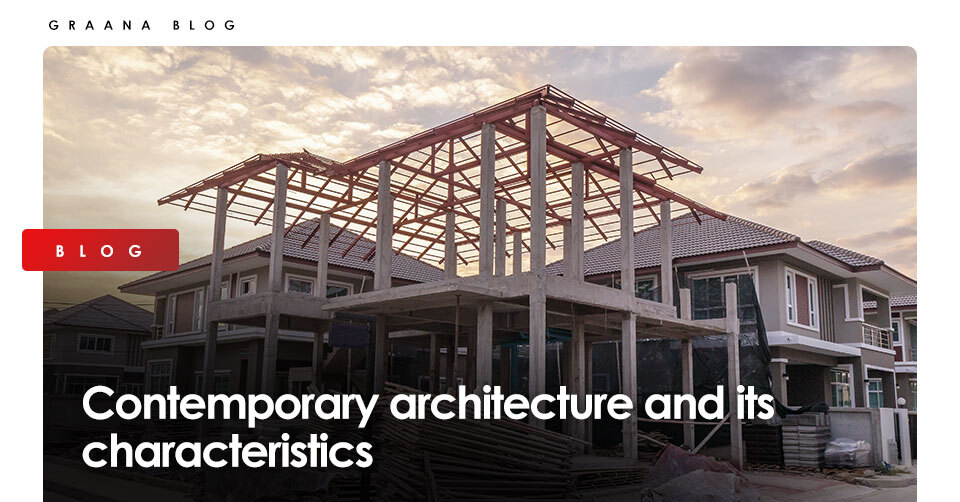
Contemporary architecture encompasses the present-day architectural style, representing structures built from the late 20th century to the current period. Designated as exemplars of contemporary architecture, these buildings often incorporate unconventional shapes, pioneering materials, and environmentally conscious construction methods.
Furthermore, these styles rely on less traditional building principles. It incorporates all of the most recent advancements and trends and deliberate updates and adjustments to architectural aspects from previous eras.
Instead of conforming to a single style or set of rules, contemporary architecture incorporates all of the characteristics and stylistic choices that are in keeping with modern culture and values. Postmodernism, high-tech architecture, and new interpretations of conventional architecture are all used by contemporary architects.
Contemporary architecture considers the roots of the location and brings a modern perspective. It constitutes highly conceptual forms and designs that resemble sculptures reduced to a grand scale.
Contemporary architecture has gained popularity not only around the globe but in Pakistan as well in recent years due to its numerous advantages. Pakistani architecture design is characterized by its diversity. Contemporary structures snuggle with many historic structures, forming a beautiful amalgamation.
Graana.com brings you a few characteristics of contemporary architecture.
One of the most common ways contemporary architecture defies tradition is through the use of unconventional materials. It uses innovative and sustainable materials that are durable, cost-effective and eco-friendly.
Contemporary structures frequently use large glass walls or windows. Metal, concrete, wood, and stone are also among the various natural or biological elements frequently used.
The inclination towards bright, open areas is another distinguishing feature of contemporary architecture. Architects are adopting open rooms that flow from one to the next instead of utilising walls to delineate each room in a structure.
It provides one enormous space with subtle elements to distinguish what used to be separate spaces with a different unconventional geometric floor plan. Architects are blurring the lines between rooms and between the indoors and outside.
Many new homes include glass balustrades, which allow light and visual flow to freely flow throughout the space. Contemporary architecture is not about compartmentalising spaces; instead works to blend it all. As the world is more and more moving towards coexistence and the intersection of ideas and beliefs, the contemporary architecture follows suit.
Contemporary architects are no longer constrained to linear designs, as they now have access to a vast array of cutting-edge materials and construction techniques. This includes the potential to create more complex, accurate, and novel forms using laser-cutting technologies and 3D printing.
Computer renderings conjure glimpses of the future in hyper-realistic detail. There was a time when this seemed impossibly futuristic and solely abstract but is now possible as the new generation of buildings defy logic.
Homes have been built with slanted roofs for ages to keep water, snow, and ice off the roof. In colder climes, the sloped design has reduced moisture damage and structural damage caused by the weight of collected rainwater.
Architects are now favouring flat roofs. The flat design appears sophisticated, along with giving a clean aesthetic feel. It provides more comfort outside while also reducing the demand for air conditioning to keep the interiors cool during the summer.
Flat roofs frequently have drooping edges that provide shade to the surrounding area, saving money and lowering the carbon footprint. Also, the materials often used in roofing are PVC or rubber, which are more durable and sustain moisture more effectively.
The goal of harmony between structure and nature is a common theme in contemporary architecture. The extensive use of massive glass walls blurs the lines between indoors and outside, while overhanging roofs thrust the architecture out into the open.
Contemporary homes are frequently planned with the landscape in mind. Modern homes emphasise the pleasure of spectacular natural surroundings by including patios and balconies from the start.
Global warming is a serious concern today. It is now critical to take specific steps to ensure that nature is not threatened. As a result, today’s architects create energy-efficient structures that are environmentally friendly as well.
People’s preferences are also changing with time, and today’s informed customer prefers a place with minimal environmental impact. Contemporary buildings are visually appealing, but they are also built to be high-performing and environmentally friendly. Such buildings are a need today to mitigate the damage caused by rapid urbanisation.
Contemporary architecture evolves according to needs and circumstances. Hence, there can never be a set criterion to define it.
ISLAMABAD: The Capital Development Authority (CDA) and the Asian Development Bank (ADB) have entered into…
Islamabad: The Capital Development Authority (CDA) has announced plans to issue possession letters to allottees…
Islamabad, [24 March 2025] – Graana.com, Pakistan's leading online real estate marketplace, is proud to…
Islamabad, Pakistan – March 2025: Graana.com, Pakistan’s leading real estate platform, has proudly partnered with…
KARACHI: Sindh Local Government Minister Saeed Ghani chaired a meeting on Monday to review measures…
ISLAMABAD: The Capital Development Authority (CDA) has unveiled plans to develop a modern food street…